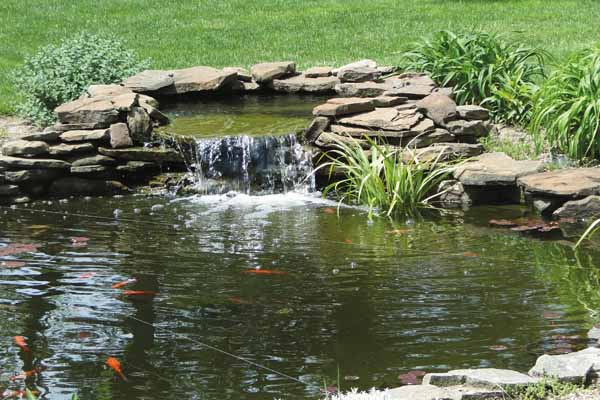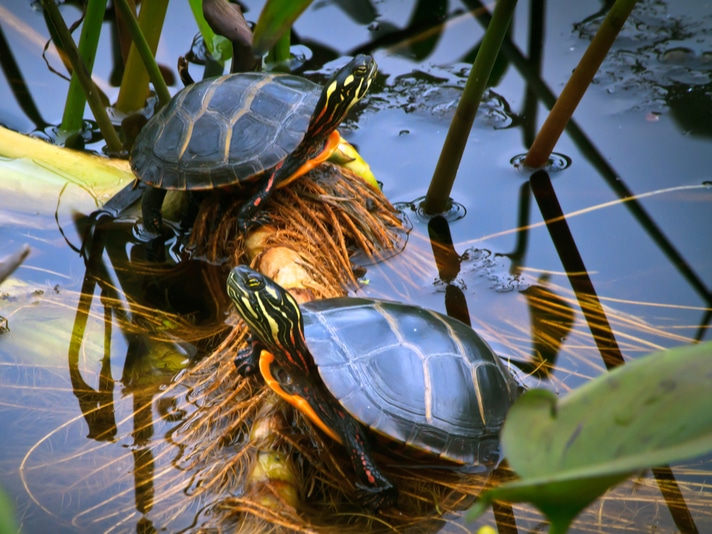Construct a healthy, attractive habitat for your turtles.
Building an outdoor pond for pet turtles is something that turtle enthusiasts dream of and new turtle owners should consider. Indoor aquariums are the most popular form of housing for many initial turtle enthusiasts and are usually suitable for small turtles, but they present a problem when it comes to staying clean, especially as the turtles grow to adult size. Filtering systems that are suitable for keeping aquarium fish may help, but they are usually inadequate for turtle inhabitants given that the water level must be kept near the top of the aquarium to work properly. Besides, most turtles will outgrow an aquarium, especially a 10-gallon aquarium, and a larger habitat will be necessary. This fact is something that new turtle owners should know when first acquiring their turtles because turtles have a long life span. The truly avid turtle enthusiast is conscious of this and seeks to provide for the turtle’s long-term needs.

Photo by Stephanie Starr
If you include a water feature such as a water fall, make sure that it does not cause too much of a disturbance. Research your turtle's needs before installing one.
Tip 1: Protect from Predators
Over the years, I and the Turtle and Tortoise Club of Florida have encouraged fellow members to build outdoor ponds for their turtles, which many of the members have done. But one factor must always be considered when placing turtles in an outdoor habitat — secure the area from the threat of predators! This is just as important as building the pond. The threat from predators, which are many, requires some form of security around the perimeter of the pond and land area.
Raccoons, birds, opossums, rats, ants, moles, dogs, cats and even neighborhood kids can be a threat. (I am not labeling kids as predators, but they can cause your turtles to disappear if they are not properly secured.) Raccoons are the worst threat, and normally they travel in packs. You rarely see them, but they are plentiful, even in the suburbs, and they can wreak havoc with your turtles! In fact, all small reptiles, birds and amphibians are in jeopardy from their presence. Building or creating a pond for turtles is somewhat of a major endeavor, and it requires a few changes from the standard garden pond. Sloped sides with a slightly rough surface must be provided so that turtles can easily enter and exit the pond, and to make it secure from predators. This slope is usually slippery, so take care when cleaning the pond.
Some form of enclosure around the pond will be required to keep predators out and the turtles in. Build the pond first, and then enclose the pond area and surrounding land area with some form of wall or fence. This could even be a completely screened-in enclosure with a small or large part of your yard sectioned off. I recommend an area close to the house that provides a good view of the pond from a window or porch. This requires a lot of work and money, and it also requires some building skill. If you are a dedicated soul, this presents no problem, but for most people, something less complicated may be preferable.
A big dog present in your yard at all times is often a good deterrent for potential predators. Just make sure the fence around the turtle pond is high enough that the dog won’t be able to get inside. A shock wire can also be used to deter raccoons, but it has to be hung in a safe area that prevents human contact.
Tip 2: Provide Sun and Shade
Having lots of shade should be considered next. Direct sunlight on the pond over many hours of the day will cause algae growth. Turtles need sun for healthy shell growth, but they also need shade when it gets too hot, so a balance of sunshine and shade is needed. Small areas of sun exposure will be suitable for the turtles providing there are basking logs and the like in the water.

Photo by Stephanie Starr
Local predators are always an issue. Protect your pond from foxes, raccoons, dogs, and other animals by putting up fence and making it difficult for them to get at your turtles.
Placing the pond next to your home will help block excessive sun rays for several hours each day, and plant vegetation that hangs over the water so it can act as a sun screen. Providing a canopy to prevent excessive sunshine will require some thought. The sun will shine on the pond from many different directions over the course of the day and year, and this must be considered. I built a pond just outside my living room with sliding glass doors to provide a grand scenic view. It has been 20 years since I built the pond, and I still enjoy viewing it.
Tip 3: Place Logs Around the Edge
Placing logs extending into the pond is essential for turtles. Many species, especially map turtles, are wary of predators while sunbathing, and they will not bask on the shore line.
Tip 4: Build it to Last
A pond may be built with cement to create a visually appealing pond shape that will be durable over the long run. You can use a pond liner, but keep in mind that it is harder to mold into interesting shapes, and it is less durable. It is still suitable, but it won’t last as long as cement.
If using a tarp to build a pond, there are other things to be considered. Black tarps are used for most fish ponds, but black absorbs heat and encourages algae growth, therefore I recommend a canvas tarp that can be bought at an awning shop. These come in many colors and are durable. Select a light tan color for a more natural look. Most of the tarps come in 5-foot widths, but you can have sections glued together at the store for a wider width. The tarp length usually extends 100 feet or more, so you can choose any length desired.
I recommend a cement pond that is built 3 to 4 inches thick, with chicken wire embedded in the cement to enhance the strength. It is also recommended that you have professional cement layers apply the cement to ensure a finished surface. You or hired help may dig the pond area to the your specifications. A cement mixer will be required, and one bag of cement will cover about 2 to 3 square feet.
Cement that is under water all the time will not expand or contract, so it should not crack or leak. Some of my ponds were built more than 30 years ago and they still have never leaked.
TIP 5: Think Big
Think big when building your pond. The more turtles and the larger they get, the more space they will need. A pond of at least 80 square feet should be considered for five to 10 turtles, depending on their size, with one side deeper for easier drainage, if desired. Easy shoreline access on the deep side should also be provided.
TIP 6: Pond Water Quality
Falling leaf litter may be a constant aggravation for the pond owner, but leaves make the water more acidic, and over time, the pond will have a PH level that inhibits algae growth. This is a good thing. Ponds should stay clear as far as algae growth is concerned. Leaf sediment can be found on the bottom of all my ponds, but it is rarely churned up by the turtles, so the surface water remains clear and the turtles are very visible.
If the pond is surrounded by plants, the plant litter will continually plug up the filter. I opted for a natural pond without a filter. My turtles remain in excellent health in this environment and their laminae plates peel on a yearly basis, exposing their beautiful shells. I have more than 200 turtles, and 20 ponds, and I consider the upkeep minimal because I prefer to leave the ponds in a natural state. I also introduced small fish, crayfish and snails for a fairly balanced habitat.
If a drain is desired, it should be installed with many small holes that enter into a large, 4-inch pipe to prevent clogging. A low or deep drain area will also be needed. A sump pump, which can be obtained at most hardware stores, can be used to drain a pond if there is no drain, but it will need to be enclosed in a container with holes in it to prevent the pump from getting clogged. I found a perfect plant pot at a garden shop with plenty of holes in it.
Always Research First
Cold weather will kill turtles that normally reside in warm regions of the world, so I recommend buying turtles that come from cool or cold climates. Do your research before buying exotic turtles, especially if you live in a northern region of the U.S. The leaf litter accumulating in the pond will provide some warmth and hiding places for cold-hardy turtles during the winter season. Turtles from warm regions of the world will have to be brought inside during cool months.
When I lived in Japan, I observed a lot of small, walled-in garden ponds. The Japanese don’t have the space that we have, so building small garden ponds definitely appeals to them. These usually cover a room-sized area and include bridges, stepping stones, plants and platforms over and around the pond, to create a scenic and secluded area to relax and enjoy nature. Fairly large plants placed around the perimeter of the pond are ideal for many reasons, but if you include them, be sure there is access to them for occasional trimming. A bridge can be an added feature and provides shelter and security for the turtles. As with all projects, if you are going to do it, then do it well. Before you ever come home with a turtle, make sure you have the pond finished and running. Habitats for animals should always be considered before acquiring them. By setting up a pond that meets their needs and is built to last, you and your turtles will have an area to enjoy for years to come.
Marvin Bennett is an avid turtle enthusiast and professional artist, who has painted more than 200 different species of turtles and tortoises. He has made his primary living as a portrait and caricature artist. Contact him at turtleprints@cfl.rr.com.


